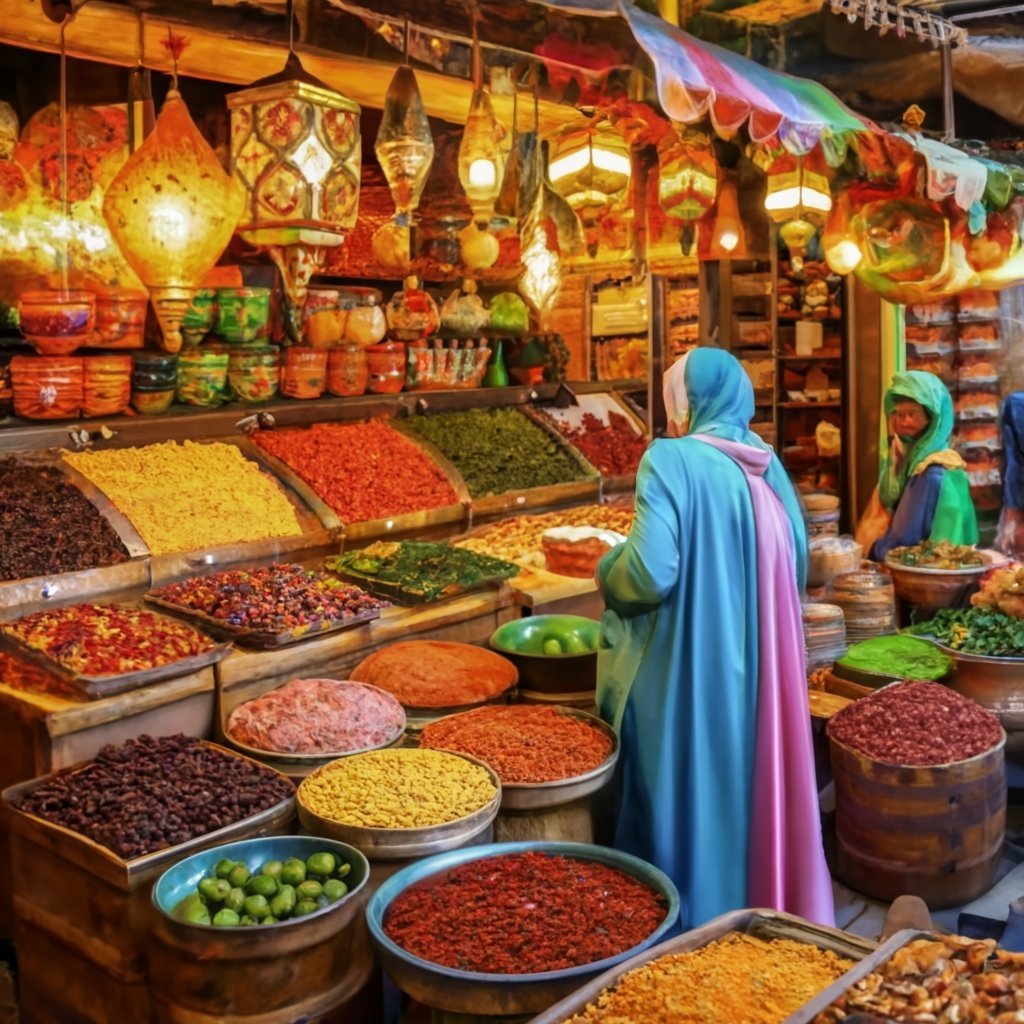Your cart is currently empty
10 Essential Middle Eastern Spices You Need in Your Kitchen
Introduction to Middle Eastern Spices
Middle Eastern cuisine is a rich tapestry of flavors and aromas, deeply rooted in history and culture. The use of spices in this region's cooking is not just about adding flavor but also about creating an experience that transcends the ordinary meal. Each spice carries its own story, blending the ancient with the modern, and transforming simple ingredients into culinary masterpieces.
In the bustling markets of the Middle East, spices are more than just commodities; they are treasures, carefully selected and blended to create the perfect harmony of taste and aroma. From the fragrant fields of coriander to the sun-kissed sumac berries, each spice is a testament to the region's love affair with food.
As you embark on this flavorful journey, let's explore the essential spices that define Middle Eastern cuisine. Whether you're a seasoned chef or a curious food enthusiast, these spices are sure to add a touch of magic to your kitchen.
1. Cumin: The Quintessential Spice
Cumin, with its earthy and slightly bitter notes, is a cornerstone of Middle Eastern cooking. It is the soul of many dishes, imparting a warm depth that is unmistakable. Its robust flavor makes it ideal for meats, stews, and soups. Cumin's versatility is evident in its ability to blend seamlessly with other spices, creating a symphony of flavors.

The History of Cumin
Cumin's journey began in the ancient civilizations of the Middle East, where it was not only a culinary staple but also a symbol of love and fidelity. It has been a constant companion in the kitchens of the region, passed down through generations as a legacy of taste.
How to Use Cumin
To fully release its aroma, cumin seeds are often lightly roasted before being ground. This simple step can elevate a dish, adding a depth that is both comforting and intriguing. Cumin is the star in many traditional Middle Eastern recipes, lending its distinctive flavor to dishes like kebabs and tagines.
2. Coriander: A Fragrant Delight
Coriander, with its lemony, floral notes, brings a fresh and slightly sweet dimension to Middle Eastern dishes. It is both a herb and a spice, with its leaves and seeds used in different culinary contexts.

Coriander in Middle Eastern Cooking
In Middle Eastern cuisine, coriander seeds are often used whole or ground, adding a subtle yet complex flavor to curries, marinades, and spice blends. Its leaves, known as cilantro, are a popular garnish, adding a burst of freshness to dishes.
Pairing Coriander with Other Spices
Coriander pairs beautifully with cumin, forming a flavor duo that is the backbone of many spice mixes. This combination can be seen in the classic Middle Eastern spice blend, Ras el Hanout, which often features coriander as a key ingredient.
3. Sumac: The Zesty Secret
Sumac is a hidden gem in the spice world, offering a tart, lemony flavor that can transform a dish. This deep red spice is made from the dried berries of the sumac bush, native to the Middle East.

Sumac's Unique Flavor Profile
Sumac's sourness is more subtle than lemon, with a hint of fruitiness that adds complexity to dishes. It's a fantastic seasoning for grilled meats, salads, and dips, bringing a vibrant zing that awakens the palate.
Using Sumac in Cooking
Sprinkle sumac over hummus or baba ganoush for an extra layer of flavor, or use it as a rub for grilled meats. It's also a key ingredient in the spice blend za'atar, which is a staple in Middle Eastern pantries.
4. Turmeric: The Golden Spice
Turmeric, with its bright yellow hue, is not just a spice but also a canvas of color. Its mild, earthy flavor and vibrant color make it a favorite in Middle Eastern cooking.

The Health Benefits of Turmeric
Turmeric is renowned for its anti-inflammatory and antioxidant properties, making it a spice that's good for both the palate and the body. It adds a warm, slightly bitter taste to dishes, balancing the flavors beautifully.
Incorporating Turmeric in Your Kitchen
Turmeric is often used in rice dishes, lending them a stunning golden color and a subtle flavor. It's also a key ingredient in curries and stews, adding depth and warmth. Explore turmeric's versatility in your own kitchen by experimenting with different combinations.
5. Cardamom: The Aromatic Wonder
Cardamom is a spice that commands attention. Its intensely aromatic, sweet, and spicy notes make it a valuable addition to both sweet and savory dishes in Middle Eastern cuisine.

The Unique Flavor of Cardamom
Cardamom comes in two varieties: green and black. Green cardamom is more commonly used in Middle Eastern cooking and has a more delicate, sweet flavor. It's often used in desserts, coffee, and spice blends.
Creative Ways to Use Cardamom
Try adding ground cardamom to your coffee for an authentic Middle Eastern touch. It can also be used in baking, imparting a unique flavor to breads and pastries. Discover the charm of cardamom in your home baking adventures.
6. Saffron: The Luxurious Spice
Saffron, often referred to as the 'gold of spices', is prized for its unique flavor and vibrant color. Derived from the stigmas of the saffron crocus, it's one of the most expensive spices in the world due to its labor-intensive harvesting process.

Saffron in Middle Eastern Cuisine
In Middle Eastern cooking, saffron is used sparingly but effectively. It imparts a rich, honey-like flavor and a beautiful golden hue to dishes like biryani, paella, and various rice dishes.
How to Use Saffron
To maximize its flavor, saffron threads are often soaked in warm water or milk before being added to dishes. This releases their aromatic oils, ensuring that their distinctive taste permeates the dish. Explore the magic of saffron in your rice and grain dishes for a touch of elegance.
7. Allspice: The Flavorful All-Rounder
Allspice, despite its name, is not a blend but a single spice. It's derived from the dried berries of the Pimenta dioica tree and has a flavor that resembles a combination of cinnamon, cloves, nutmeg, and pepper.
The Versatility of Allspice
Allspice is a versatile spice used in both sweet and savory dishes in Middle Eastern cuisine. It adds warmth and depth to stews, marinades, and even desserts.
Incorporating Allspice in Cooking
Allspice can be used whole or ground. It's particularly effective in meat dishes and is a key ingredient in traditional Middle Eastern stews and kebabs. It also adds a warm note to baked goods and desserts.
8. Za'atar: The Quintessential Middle Eastern Blend
Za'atar is not a single spice but a blend that typically includes sumac, sesame seeds, thyme, and oregano. It's a staple in Middle Eastern kitchens, cherished for its savory, tangy, and nutty flavors.

Za'atar's Cultural Significance
In Middle Eastern culture, za'atar is more than a spice blend; it's a symbol of hospitality and tradition. It's often served with olive oil and bread, a simple yet profound offering to guests.
Creative Uses of Za'atar
Za'atar can be sprinkled over vegetables, mixed into yogurt for a savory dip, or used as a rub for meats. Its versatility makes it an essential component in your spice rack.
9. Baharat: The Warm Spice Mix
Baharat, meaning 'spices' in Arabic, is a warm and aromatic spice blend commonly used in Middle Eastern cooking. The composition of baharat can vary, but it often includes black pepper, coriander, paprika, cardamom, nutmeg, cumin, and cloves.
The Role of Baharat in Cooking
Baharat is used to season meats, fish, and poultry, adding a complex flavor profile that enhances the natural tastes of the ingredients. It's also a great addition to soups, stews, and sauces.
Experimenting with Baharat
Try using baharat in your next meat dish or as a seasoning for grilled vegetables. Its rich, warm flavors are perfect for cozy, comforting meals.
10. Dried Lime: The Sour Accent
Dried lime, also known as black lime, is a staple in Persian and Middle Eastern cooking. These limes are boiled in saltwater and then sun-dried, resulting in a tangy, slightly bitter flavor.

The Unique Taste of Dried Lime
Dried lime adds an intense, citrusy flavor to dishes, different from fresh lime juice. It's commonly used in stews, soups, and tagines, where it imparts a distinct sourness that balances the richness of the other ingredients.
How to Use Dried Lime
Dried lime can be used whole, sliced, or ground. Add it to your stews and tagines for a burst of citrus flavor, or grind it into a powder to use as a seasoning for meats and vegetables.
Conclusion
These ten spices and spice blends are the pillars of Middle Eastern cooking, each bringing its unique flavor and aroma to the table. By incorporating them into your kitchen, you can explore the rich culinary heritage of the Middle East and transform ordinary meals into extraordinary experiences.
Stay tuned for the final section, where we'll delve into practical tips for sourcing and storing these spices, along with exciting recipes and usage ideas to inspire your culinary adventures.
Tips for Sourcing and Storing Spices
Finding High-Quality Middle Eastern Spices
To ensure the authenticity and quality of your Middle Eastern spices, consider sourcing them from specialty stores or reputable online retailers like 24Shopping. Look for stores that have a high turnover, as this often means their spices are fresher.
Storing Spices for Freshness
Proper storage is key to maintaining the flavor and aroma of your spices. Store them in airtight containers in a cool, dark place. Avoid exposure to heat, light, and moisture, as these can cause spices to lose their potency faster.
Recipes and Usage Ideas
1. Classic Middle Eastern Kebabs
Marinate your choice of meat in a blend of cumin, coriander, and baharat. Grill to perfection and serve with a sprinkle of sumac and a side of tahini.
2. Aromatic Biryani
Infuse your rice with cardamom, saffron, and turmeric for a fragrant and colorful biryani. Pair it with spiced meat and vegetables for a hearty meal.
3. Sumac Roasted Vegetables
Toss your favorite vegetables with olive oil, za'atar, and sumac. Roast until caramelized and serve as a delicious side dish or add them to your salads.
4. Baharat Spiced Chicken
Rub chicken with a mixture of baharat and olive oil. Roast or grill for a flavorful dish that pairs well with rice or grains.
5. Persian Stew with Dried Lime
Create a traditional Persian stew (Khoresht) by incorporating dried lime for its unique citrusy flavor. This stew is perfect with canned beans or lentils.
Conclusion: Embracing Middle Eastern Flavors
Embracing Middle Eastern spices in your kitchen is not just about adding new flavors to your dishes; it's about embarking on a culinary journey that celebrates the rich history and culture of the region. These spices offer a window into the diverse and vibrant world of Middle Eastern cuisine, inviting you to explore and experiment.
Remember, cooking is an art, and spices are your palette. Whether you're trying a traditional recipe or creating your own fusion, these ten essential Middle Eastern spices are sure to inspire and delight. So go ahead, add a pinch of adventure to your cooking and savor the journey!
Additional Resources
For more information and inspiration on Middle Eastern spices and cooking, explore the insightful articles and recipes on websites like The Spruce Eats, Serious Eats, and Food52. These resources offer a wealth of knowledge and ideas to enhance your culinary skills and understanding of these flavorful ingredients.



